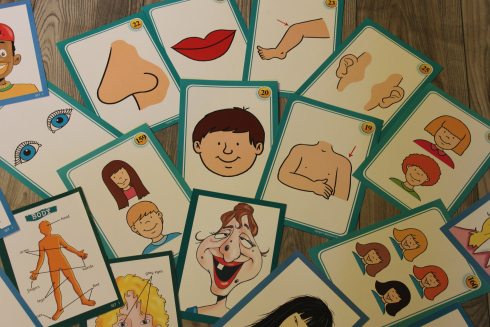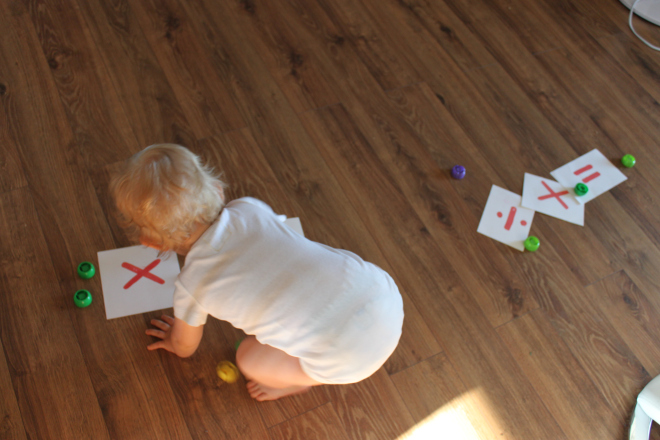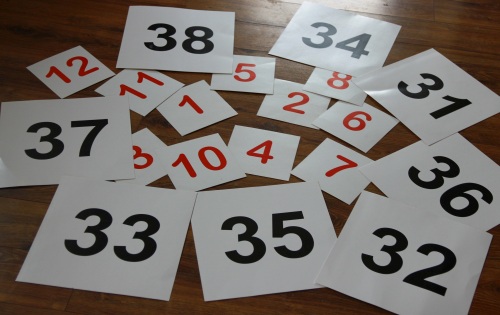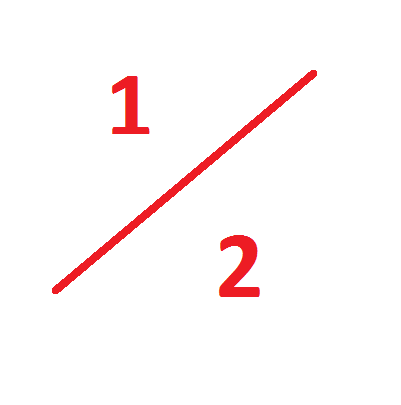
FRACTIONS
Yeah…I am crazy enough to start fractions with a 13-month-old toddler. It’s hard to believe it works but I am still experimenting with it. The question arises again how long this step should last and if I should ask Maja any questions or maybe just present the cards.
Well…I must admit I got used to the fact that Doman goes into detail when describing the first steps of his maths programme but he doesn’t elaborate much on next steps. When it comes to the next stages in maths he doesn’t go into detail at all. According to him everything that follows depends on parents’ creativity and his suggestions are just hints as for which way to go to make your baby more intelligent and more passionate about maths. I am following my gut instincts now.
If I wanted to stick to the order of things to teach as presented in Doman’s book “How to Teach Your Baby Maths,” we would be doing something else now. However, I have come to the conclusion that these are suggestions only and that I will follow them the way it suits me best. Thinking about myself I skipped one step intentionally (of course we will cover it later) and I started presenting fractions to Maja. There are two reasons for this:
1) the preparation of the previous step with comparisons was time – consuming
2) I wasn’t able to prepare our “sessions” the day before because I didn’t have enough = or > signs (it was my mistake but I decided not to spend time on producing these signs halfway this step :P).
Due to all this, I decided to do something less time-consuming, requiring less preparation. I also bear in mind that Maja needs really fast lessons now. It is possible to present fractions in a flash because I have only two cards in each operation.
What does each of these “lessons” look like?
I take, for example, the card with 20 dots and I say „one fifth of twenty equals four” (1/5 z 20 = 4) immediately showing the card with 4 dots. Then, we have two more operations and this is the end. We repeat this three times each day. I use different cards each time. There are some limitations, of course, as it is not possible to show all the fractions using only the dot cards. However, the choice is big enough.
During the first week, I presented the same fraction in all sessions on a given day, for example: ½ of 20 = 10, ½ of 50 = 25, ½ of 14= 7. Right now it’s our second week and I started mixing fractions. I present, for example, the following: 1/7 of 7= 1, 1/5 of 30 =6, 1/3 of 9= 3. After this presentation I give Maja a problem-solving opportunity with two solutions to choose from. The rules for this are exactly the same as during the previous steps.
During the first week we exhausted all possible options with 1/10 i 1/9
SIGHT-READING WITH GLENN DOMAN
MAJA DOESN’T HAVE TIME FOR OUR “LESSONS”
Actually, I expected this sooner or later because Doman devotes one chapter in his book “How to Teach Your Baby to Read” to discuss how we should approach a baby at different stages of development beginning from birth up to the age of three. The older a child, the more challenging teaching is for a parent. We can put a card with an enormous red dot over a newborn’s cot and then after a few days replace it with two dots and three dots showing more and more of them in the course of time. A newborn will stare at the dots for sure. I know that because I experienced this with visual stimulation cards. I really regret not starting maths and reading programme earlier.
The more mobile a child is, the more it is interested in the world around it. At times it may seem that it is fed up of cards. Doman claims it is not the case because each child wants to learn and enjoys learning virtually everything. A child is never fed up with learning. We just need to adapt our approach to its physical and mental development. What works with a newborn or an older baby, won’t necessarily work with a toddler. Anyway, if my experiment works, I will strongly advise other parents to start implementing the Doman method from birth. I will really congratulate those and admire those who will successfully stand up to the challenge of starting with the Doman programme with a toddler who has just learned to walk. Maybe it is easier with a two-year-old but I don’t know yet.
We have been doing well although Maja’s interest in the cards varied from the to day and there were days, of course, when she didn’t seem very interested in reading or maths. The fact that Maja learned to walk has changed everything. My mum has already started panicking because she didn’t walk when she was one. She told me that if I didn’t feed her properly, she wouldn’t be able to walk even at the age of two. For my mum, feeding a child properly means force-feeding and I am against it and I feed Maja in my own way. I don’t mind if Maja eats just ½ of her portion and she doesn’t want anymore. She shakes her head and says “NIE” (“no” in Polish!) and for me everything is clear.
Now she can walk and I am not able to show her the usual 4 sight-reading sets daily for a few days. We are doing well with maths and flashcards. The situation with reading cards is like with food. If she doesn’t want them, I won’t push her. Of course, I try at different times of the day but I don’t always succeed.
I respect my baby and if it happens that she plays with a toy, I never interrupt her with the cards even if it is a time for our “lesson.” We often go for longer walks and the world outside is too interesting for her to look at the reading card. I tried to take the cards with us only once and I decided it doesn’t make any sense.
THE READING PROGRAMME MODIFIED ACCORDING TO DOMAN’S PRINCIPLES
Maja learnt to walk at the age of 13 months which is quite late I guess but thanks to this we have managed to complete almost the whole reading programme (we started with sight-reading when she was 9 months old, maths was introduced much earlier). I expected that all the reading cards would have been presented to Maja by June provided we keep on with the same speed.
She can walk and because of that I will complete the whole set of reading cards in English a bit later but, hopefully, I will manage to do it before returning to work. I guess such a critical moment may happen much earlier because it depends on the time when a child becomes more mobile. I agree with Doman that we need to observe our baby. If we notice that, suddenly, for a few days, we aren’t able to present as many cards as we planned, we have to modify our plan. We have to exclude other reasons, of course. However, if this happens not because of us and our lack of time or because we spend less time with our baby but because our baby doesn’t have time for it, it means that our plan is too intensive and that the frequency of showing the cards is too high. I decided to do 3 reading sets daily instead of 4. I will do less if necessary.
We can’t reduce our reading plan from one day to another in a flash. We need to do this gradually because each card needs to have a certain lifespan meaning it has to be shown a certain number of times. If we decide we need to reduce the number of cards to be presented daily, one day we should add 3 new cards instead of usual 4. I started doing this yesterday. I still have 4 reading sets but the 4th one consists less cards. Today I haven’t managed to present 3 cards for the third time. Tomorrow I will put away the cards with a lifespan of 5 days. This way the day after tomorrow we will have only 3 reading sets. I think it is possible I will have to reduce our reading plan even more.
HAVING FUN WITH SIGHT-READING -INTENSIVE MORNINGS AND EVENINGS
Doman must have really worked with lots of children because in our case it is exactly as he says in his book. Maja is more interested in our “lessons” in the morning and in the evening. I think I will stop trying throughout the rest of the day. I am able to show her 5 cards in a flash in the morning. She keeps looking at them throughout the session without taking her eyes away for a second. In 15 minutes we have another “lesson”….quite nice.
In the evening, I put the cards face down on her mat. She picks them up, brings them to me and looks at the word while I read it to her. I let her stamp on them and many other things. We spend the rest of the day walking, reading books, “talking” to each other, monkeying around, playing with her toys etc. She doesn’t have much time for the cards because there are so many interesting things around: she needs to taste a stone she finds, she spots a ladybird on a bush, she needs to take mummy’s pen away while she studies Italian on a blanket and a spare one, too.
OUR LEVEL IN SIGHT-READING
We keep on reading short and long sentences using the smallest possible font for kids. We have already done the whole reading set that I bought from WczesnaEdukacja. I had discovered some mistakes and I sent a letter of complaint to the publishing company. They agreed to print the incorrect sentences again together with my own personal sentences for free. The sentences that I created are mainly based on our first 15 words, which I mentioned in that entry. We have already done all this. At present we are reading those sentences and it’s a pity Maja has such a short attention span just now. It seemed to me that these phrases may be more interesting for her, because she has heard me saying them a few times before. I added some sentences taken from our nursery rhymes as well.
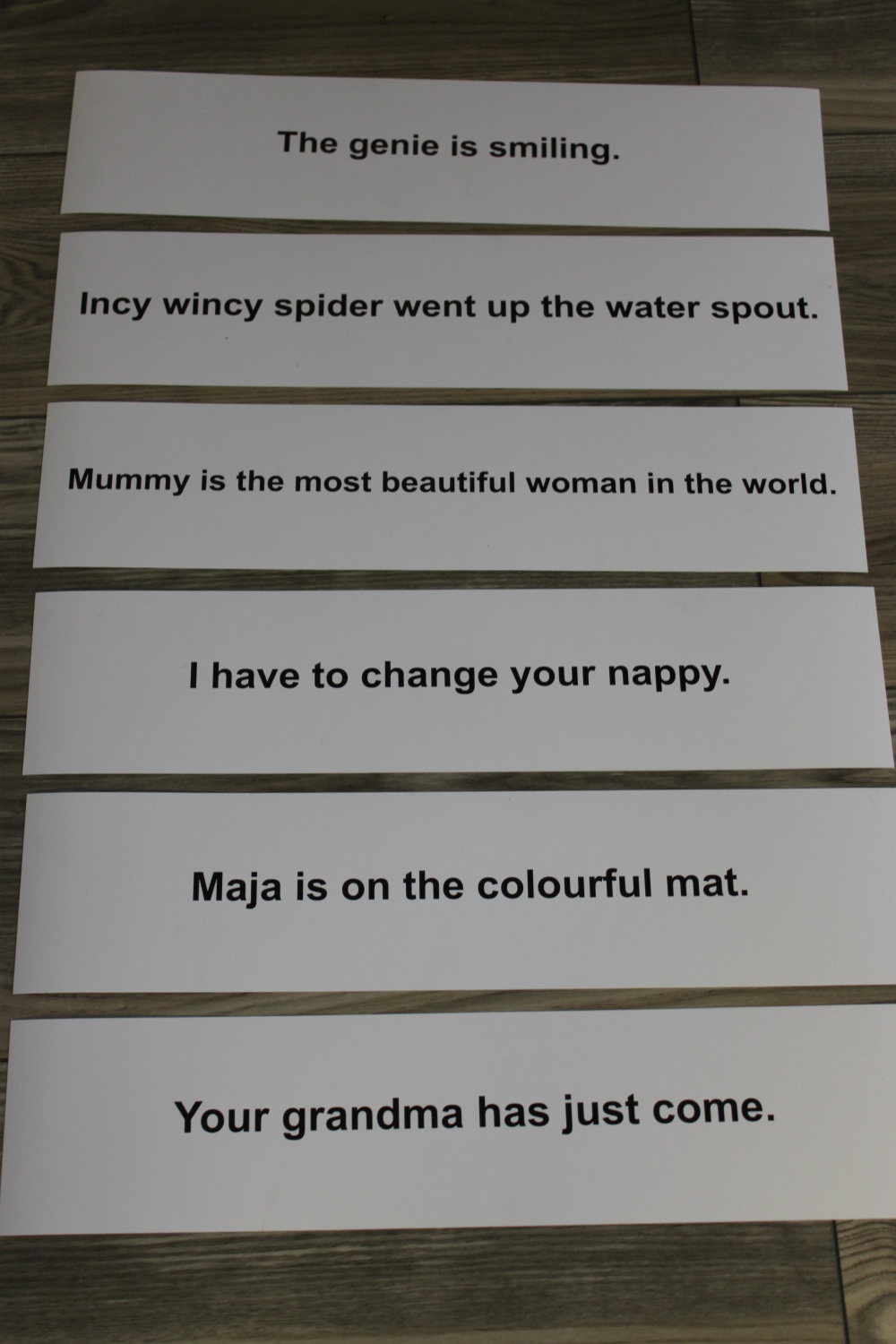
IS THAT EVERYTHING WHEN IT COMES TO DOMAN’S SIGHT-READING PROGRAMME?
Of course, it is not the end. We have done all the reading cards but I think I will show her some of them from time to time. After completing what we have done or even before finishing all cards, it is time for the next step – personalized books. However, I am going to explain it in detail in the next blog entry.
TEACHING YOUR BABY ENGLISH – VOCABULARY ENRICHMENT
PARTS OF THE BODY
I have already mentioned that I have hundreds of flashcards as a teacher of English. I use them both at school and at home with my baby. We have already completed all flashcards with toys. I also revised the words DIFFERENT showing two different cards and THE SAME showing two cards which are exactly the same which I already introduced before. A new word appeared: SIMILAR because I have two cards with red cars but they are not the same.
Quite recently our baby has started being in the parts of her body and other people’s bodies. She is really curious about her feet. She points to my nose or an eye etc. during breastfeeding. Last time she was having a bath she discovered her hair. and this was my incentive to start the flashcards illustrating two categories: parts of the body and appearance.
